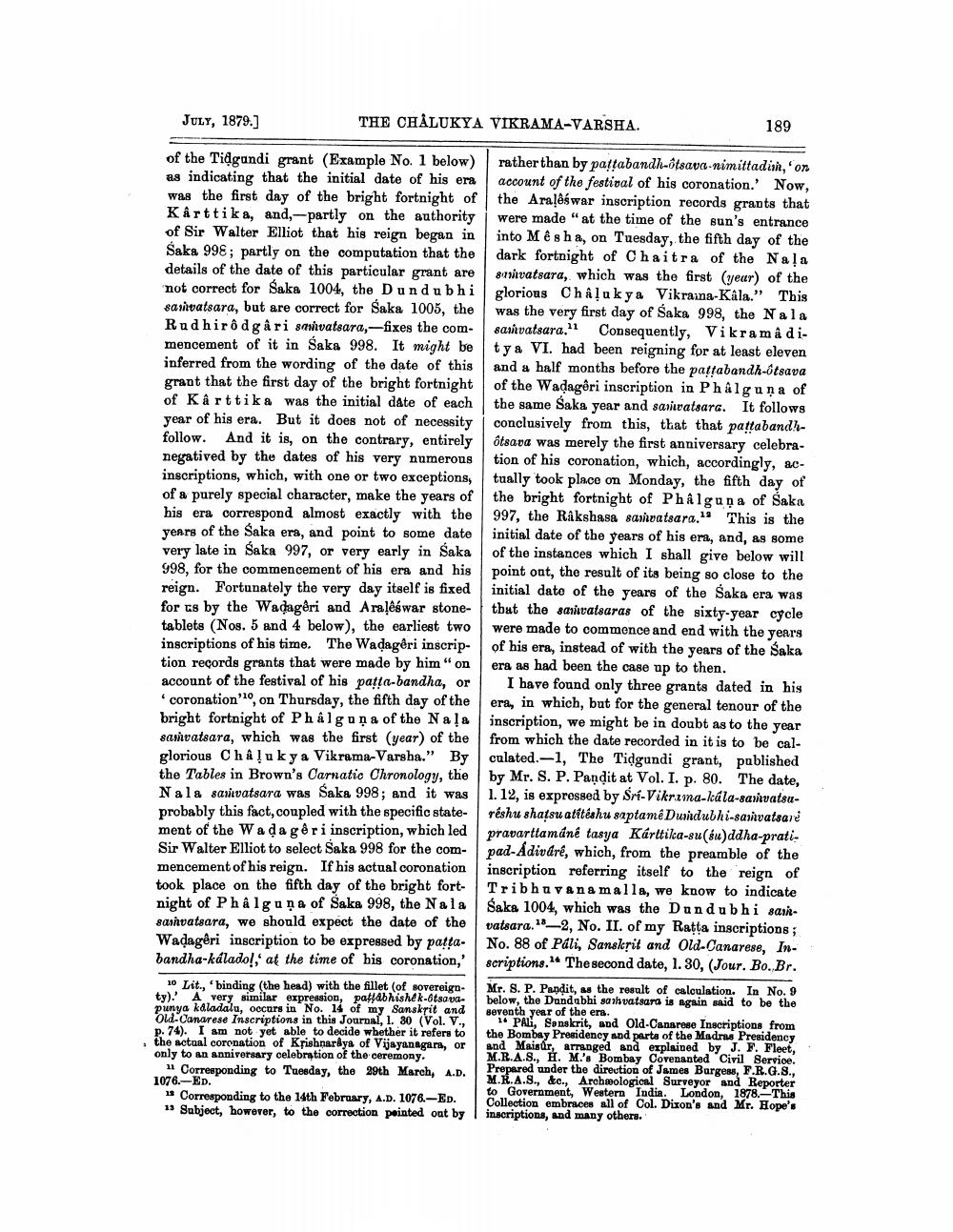________________
JULY, 1879.]
THE CHÅLUKYA VIKRAMA-VARSHA.
189
of the Tidgandi grant (Example No. 1 below) rather than by pattabandh-otsava-nimittadini, on as indicating that the initial date of his era account of the festival of his coronation. Now, was the first day of the bright fortnight of the Araldswar inscription records grants that Karttika, and, -partly on the authority were made at the time of the sun's entrance of Sir Walter Elliot that his reign began in into Mêsha, on Tuesday, the fifth day of the Saka 998; partly on the computation that the dark fortnight of Chaitra of the Nala details of the date of this particular grant are smvatsara, which was the first year) of the not correct for Saka 1004, the Dundu bhi glorious Chalukya Vikrama-Kala." This sarvatsara, but are correct for Saka 1005, the was the very first day of Saka 998, the Nala Radhirôdgâri smivatsara, -fixes the com- sarvatsara."1 Consequently, Vikram â dimencement of it in Saka 998. It might betya VI. had been reigning for at least eleven inferred from the wording of the date of this and a half months before the pattabandh-otsava grant that the first day of the bright fortnight of the Wadagðri inscription in Phålguna of of Kârttika was the initial date of each the same Saka year and sarwatsara. It follows year of his era. But it does not of necessity | conclusively from this, that that pattaband! - follow. And it is, on the contrary, entirely ôtsava was merely the first anniversary celebranegatived by the dates of his very numerous tion of his coronation, which, accordingly, acinscriptions, which, with one or two exceptions, tually took place on Monday, the fifth day of of a purely special character, make the years of the bright fortnight of Phålguņa of Saka his era correspond almost exactly with the 997, the Rakshasa sasivatsara." This is the years of the Saka era, and point to some date initial date of the years of his era, and, as some very late in Saka 997, or very early in Saka of the instances which I shall give below will 998, for the commencement of his era and his point out, the result of its being so close to the reign. Fortunately the very day itself is fixed initial date of the years of the Saka era was for us by the Wadagðri and Araļêswar stone- tbut the sariwatsaras of the sixty-year cycle tablets (Nos. 5 and 4 below), the earliest two
were made to commence and end with the years inscriptions of his time. The Wadagêri inscrip- of his era, instead of with the years of the Saka tion records grants that were made by him "on era as had been the case up to then. account of the festival of his patta-bandha, or I have found only three grants dated in his
coronation', on Thursday, the fifth day of the era, in which, but for the general tenour of the bright fortnight of Phálguna of the Nala
inscription, we might be in doubt as to the year sasivatsara, which was the first (year) of the from which the date recorded in it is to be calglorious Chalu kya Vikrama-Varsha." By culated.-1, The Tidgundi grant, published the Tables in Brown's Carnatic Chronology, the by Mr. S. P. Pandit at Vol. I. p. 80. The date, Nala sasivatsara was Saka 998; and it was 1.12, is expressed by Srí Vikrama-kála-sarvatsuprobably this fact, coupled with the specific state- réshu shatsu atitéshu saptamê Duridubhi-sarvatsare ment of the Wada gêri inscription, which led pravarttamine tasya Karttila-su (buddha-pratic Sir Walter Elliot to select Saka 998 for the com- pad-Adivaré, which, from the preamble of the mencement of his reign. If his actual coronation inscription referring itself to the reign of took place on the fifth day of the bright fort Tribhavana malla, we know to indicate night of Phålguņa of Saka 998, the Nala Śaka 1004, which was the Dundubhi sartsarhvatsara, we should expect the date of the vatsara. 18—2, No. II. of my Ratta inscriptions ; Wadagêri inscription to be expressed by patta. No. 88 of Páli, Sanskrit and old.Canarese, Inbandha-kdlado!, at the time of his coronation,' scriptions." The second date, 1.30, (Jour. Bo.Br.
10 Lit., binding (the head) with the fillet (of sovereign- Mr. S. P. Pandit, as the result of calculation. In No. 9 ty).' A very similar expression, paffabhishek-6tsova- below, the Dandabhi samvatsara is again said to be the punya kaladalu, occurs in No. 14 of my Sanskrit and seventh year of the era. old. Canarese Inscriptions in this Journal, 1. 80 (Vol. V. ** PAL, Sanskrit, and Ola-Canarese Inscriptions from
p. 74). I am not yet able to decide whether it refers to the Bombay Presidency and parts of the Madras Presidency , the actual coronation of Krishnarêya of Vijayanagara, or and Maisúr, arranged and explained by J. F. Fleet, only to an anniversary celebration of the ceremony.
M.R.A.S., H. M.'s Bombay Covenanted Civil Service. 11 Corresponding to Tuesday, the 29th March, A.D.
Prepared ander the direction of James Burgess, F.R.G.S., 1076.-ED.
M.R.A.S., &c., Archeological Surveyor and Reporter
to Government, Western India. London, 1878.This 1 Corresponding to the 14th February, A.D. 1076.-ED.
Collection embraces all of Col. Dixon's and Mr. Hope's 13 Subject, however, to the correction pointed out by inscriptions, and many others.




